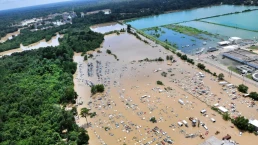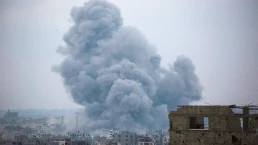Record heat is bringing new threats to our health that go far beyond the obvious risks.
by Zoya Teirstein, Grist
For weeks now, a “death ridge” of heat has been hovering over the United States, ushering in triple-digit temperatures in parts of the South and West. About a third of the nation is currently under a heat advisory, and casualties are starting to rack up. Texas has reported multiple fatalities, and Arizona has attributed at least 12 deaths to heat this summer so far. Those numbers will rise as the summer continues.
The U.S. heat wave, dire as it is, is not a global outlier. It’s the latest in a string of deadly hot spells that have gripped the planet in recent years. Last year, for example, a record-breaking heat wave in Europe, driven by climate change, was responsible for the premature deaths of at least 61,000 people, according to a study published in Nature Medicine last week. Heat is swiftly becoming a ubiquitous threat to people’s health.

Heat affects us in all of the expected ways — dehydration, heat exhaustion, hyperthermia, and heatstroke. But it claims lives in far subtler ways, too: Gun deaths spike during heat waves, suicides rise, there are more drownings as people flock to bodies of water to try and keep cool. (We’ll be unspooling some of the drivers behind those trends, especially how heat erodes mental health, later in this series.)
Perhaps the most unexpected connection is the effect extreme heat has on deadly infectious diseases — on illnesses caused by mosquito and tick bites, dangerous bacteria floating in bodies of freshwater, toxic algae lurking in saltwater, and deadly fungal spores that filter through the air around us and lurk deep inside of the earth. It exacerbates these illnesses by creating conditions for certain carriers of disease to proliferate, and by forcing humans into closer contact in cooling centers, in public pools, and at beaches. Think mosquitoes breeding by the millions in unusually tepid pools of water, and communities in developing countries with subpar sanitation systems cooling off in bacteria-laced water.
A meta-analysis that looked at disease outbreaks during and following extreme climate events, including heat waves, found links between mosquito-borne diseases like chikungunya virus, dengue fever, West Nile virus, and St. Louis encephalitis and extreme temperatures. The same study found links between heat and waterborne diseases such as vibriosis, a deadly bacteria that kills 1 in 5 people who develop severe symptoms. In Northern Europe, the study found that spikes in bacterial Vibrio vulnificus infections followed heat waves in 1994, 2003, 2006, and 2010. The authors saw a similar trend with a variety of other bacteria and parasites.
While attributing individual incidences of disease to a particular climate event is tricky, these results indicate that more work needs to be done to understand the connections between extreme heat and infectious disease. And it reflects what a wide array of researchers told me earlier this year, when I started asking around about what the dawn of an El Niño — the weather cycle that kicked into gear in the Pacific several weeks ago — will mean for public health. El Niño contributes to above-average warmth and a slate of erratic weather patterns across the globe.
The link between extreme heat and infectious diseases highlights an unfortunate reality of living on a planet that’s behaving fundamentally differently than it was even just a century ago: The health impacts of climate change are as varied as they are surprising. We really don’t have a good sense yet of how our lives, and our health, will be affected by these changes.
“We are not even at the beginning of the beginning of the beginning of understanding the implications of what we’re doing,” Jeff Goodell, the climate journalist and author of a new book on extreme heat, told me last week.
Recent Posts
‘Unconstitutional. Unethical. Authoritarian.’ ICE Bars Millions Of Immigrants From Bond Hearings
July 18, 2025
Take Action Now One watchdog said the new policy “seems like a blatant attempt to stop them from exercising their right to due process.”……
Americans Are Not Nearly Alarmed Enough About Climate Change
July 18, 2025
Take Action Now Americans still don’t comprehend how imminent, dangerous, and far-reaching the threat is—and journalists are partly to blame.By…
The IRS Is Building A Vast System To Share Millions Of Taxpayers’ Data With ICE
July 17, 2025
Take Action Now ProPublica has obtained the blueprint for the Trump administration’s unprecedented plan to turn over IRS records to Homeland Security…
Israel’s Sudden Assault On Syria Is Unchecked Aggression
July 17, 2025
Take Action Now Jerusalem is bombing Damascus and threatening al-Sharaa’s rule, while Washington was hoping to help the nascent government on…




